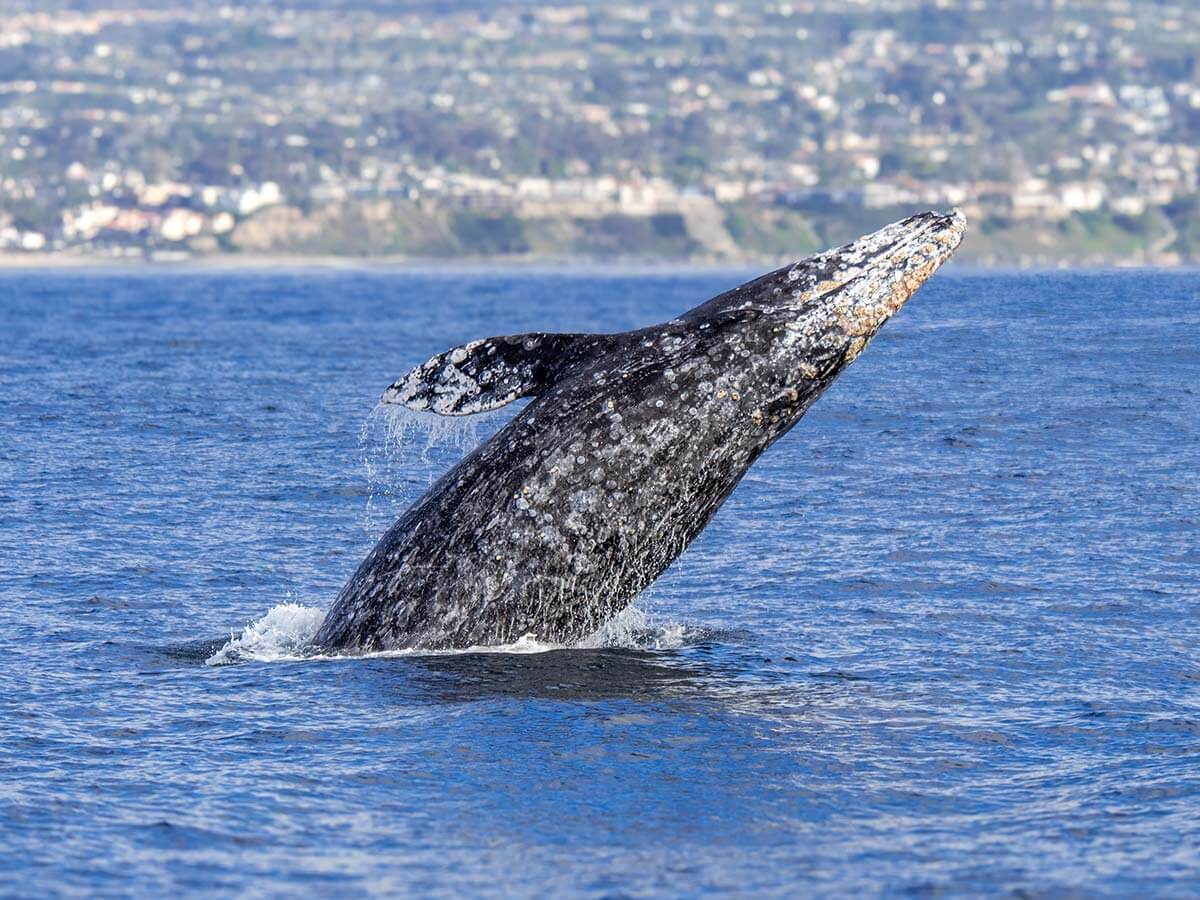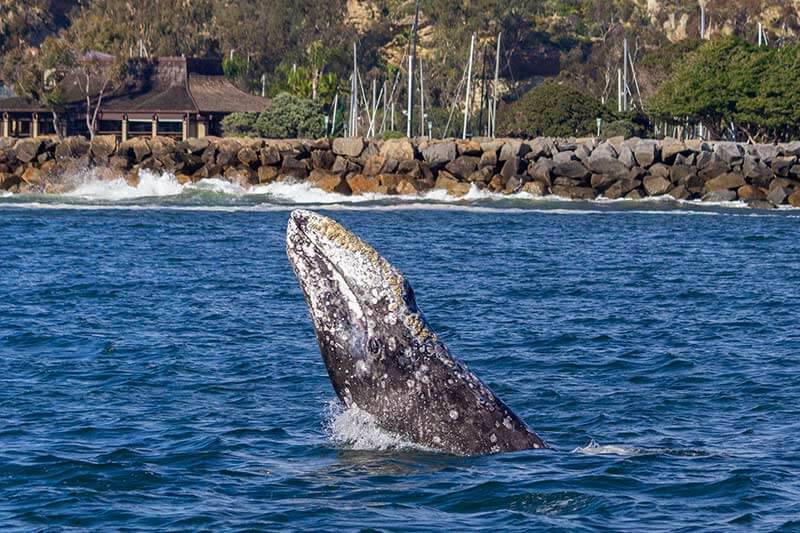Where Can You See Gray Whales in California?

Each year something magical happens along the California coastline, and from roughly December through May, gray whales journey on an annual trek from chilly Arctic waters to the warm lagoons of Baja California, Mexico. This gives whale watchers and beachgoers alike an extraordinary opportunity to see the whales as they pass and you’re almost guaranteed to cross paths with them if you have eyes on the ocean. If the question on your mind is where to get front-row seats as the whales travel along this seasonal whale superhighway, look no further! Let us be your guide to the best spots to see California gray whales.
What brings gray whales to California?
Gray whales swim over 10,000 miles roundtrip between feeding grounds in the Arctic and breeding grounds in Baja California. Talk about wanderlust! They should win awards in the animal kingdom- they make one of the longest migrations of any mammal.
The California gray whales typically arrive in Mexican lagoons around late December and stay until early spring. During this time, they mate, give birth, and nurse their calves in the warm safe harbor of the lagoons.
Around March, they begin the return trip back up north to the Arctic, often stopping in coves along the California coastline to rest.
Do all migrating whales have calves?
Not all of these northbound California gray whales will have calves with them, but lucky whale watchers will fairly easily be able to see the adorable babies swimming alongside mom for their first journey north. If you are eagle-eyed or have time to sit with a pair of binoculars, you might even be able to see migrating California gray whale mothers and calves from the shore as they journey up the coastline.
How will you know you’ve seen a Gray Whale?
All whales look different, though sometimes it’s hard to tell from the surface of the water due to some similarities. Easy ways of identifying whales will include looking at the color, size, dorsal fin, and fluke. There is no mistaking a gray whale in the water, however!

Gray Whale
Don’t mistake it for an actual rock, but if what you see resembles a massive floating hunk of granite, you’ve likely sighted a magnificent California gray whale. The gray whale is the only living species in its genus and family, Eschrichtius and Eschrichtiidae, so the distinction isn’t without reason.
California gray whales tend to have a mottled appearance in a mix of gray and lighter gray and brown patches. Covered in barnacles and commonly seen with whale lice, all 45 feet of a gray whale have a unique pattern and texture to them that isn’t seen on other cetaceans. Some of the lighter parts of the pattern even include scars left behind by barnacles that live their whole life on the whale and detach once the barnacle expires.

What sets California Gray Whales apart from other whales?
Unlike rorqual whales, the gray whale doesn’t have an obvious dorsal fin. Instead, they have a dorsal hump and a raised bumpy ridge of ‘knuckles’ two-thirds of the way down their back. The more angular fin whale seems built for streamlined swimming, but gray whales don’t follow this shape.

A California gray whale’s head is relatively small and narrow compared to the rest of its body, and it has rounded paddle-like pectoral fins. Of course, an easy way to know if you’ve spotted a gray whale is while you’re whale watching! Gray whales tend to be playful and curious and they will approach the boat for a better view of whoever is onboard. Our eye-to-eye underwater viewing pods aboard our flagship vessel Manute’a could give you an up-close and personal introduction that we can promise you will never forget!
What are the best places in California to see Gray Whales?
A large amount of gray whales will pass along the California coastline from December to May, and there are a lot of places along the coastline that will give great views of gray whales.
Up in the northern parts of California, some good coastline sightings of both whales and redwoods can be found in Eureka. Although the bay is large, it’s often cold, and rough waves can sometimes make for a choppy trip once you’re out of the 13-mile-long bay.
Monterey Bay is another great and popular place for ocean wildlife sightings. It’s well known as a marine life tourist destination because of the surrounding bay and its famous aquarium, so even if you don’t want to fight crowds for a good spot on a boat to see California gray whales, you still might have the chance to grab a bite to eat and see some sea otters nestled in the kelp forests that float just off the shore.
The Santa Barbara channel often hosts whales and other ocean life, and trips between the islands and the mainland could be another good option. If you’re looking to get a glimpse of the beautiful underwater world of the Channel Islands, we recommend a trip either scuba diving or whale watching. It’s quite a ways out though, so prepare for a full day of travel.
As far south as you can get before heading into Mexican waters lies San Diego. It’s not particularly known for whale watching, though marine life can be seen there. San Diego Harbor is set up to function down to every last inch and remains an active hub for large transport shipping and is home to many different industries and draws like the San Diego International Airport, San Diego Convention Center, Naval Station, Zoo, museums, and the Embarcadero which hosts a public fishing pier and open-air amphitheater. It is a rather busy city known for its nightlife. If you plan to venture into San Diego harbor, expect competition from marine traffic on both land and water, and prepare for big crowds, background noise, and wait times!
Of course, our favorite place to see California gray whales is here in Dana Point. We often see whales right off the jetty, and it’s no surprise they may feel safe enough to be close. Because of our community’s dedication to making the area great for whales, we were given the distinction of being the first Whale Heritage Area in the Americas.

Dana Point is an eco-lover’s dream of a beach town that prides itself on conservation ideals and higher standards for how we treat the sea. Residents and visitors of all ages are encouraged to love, advocate for, and celebrate the amazing ocean and its wildlife. We’re all in when it comes to gray whales. Beautiful images of whales adorn the city which serve as a lovely reminder of our pride in having them return each year.
Did we mention the Festival of Whales? Each year we have a festival dedicated to honoring the majestic California gray whales that migrate to Dana Point Harbor. If you’re looking for gray whales, you can’t go wrong with a three-day festival dedicated to them. It’s an immersive celebration with marine-themed activities, educational exhibits, and family-friendly entertainment that makes for a fun visit.
Speaking of visits, our small and relaxed beach town harbor is a perfect choice for a comfortable, laid-back whale watching experience while still enjoying the excitement and thrills of seeing wild whales and dolphins. We’re typically out of Dana Point Harbor and in the open ocean in about 10 to 15 minutes, so there are no worries about missing out on spectacular on-the-water sightings or having your experience occur behind any large boats or jetties. We also have a wonderful marine science center and a rocky tidal shore to explore all within a few minutes of our dock. You can always stop by Wind & Sea for a tasty lunch, and if you sit by the windows, you can sometimes watch sea lions pass by in the water below.
What’s special about Dana Point?
This naturally beautiful beach town, located between Los Angeles and San Diego, California, is world-renowned and famous for its incredible whale watching and the nutrient-dense waters that bring an abundance of species to the area. Dana Point whales are easy to find! California Gray whales travel through the Dana Point area in the Southern California Bight on their migration routes and usually pass rather close to land. Unlike nearly all other places on earth, the waters of the Southern California Bight pull nutrient-rich water into the area around Orange County. The waters are filled with a plentiful and reliable food source for a multitude of species of cetaceans and other marine life. Healthy krill populations, schools of anchovies, herring, mackerel, squid, and more are all major food sources for cetaceans. Because of its unique underwater geography, the ocean essentially funnels all of these resources, and the animals that seek them, into Dana Point.

What do gray whales eat?
When they aren’t busy traveling, California gray whales spend their time filter-feeding on the seafloor. The upwelling off the coast of southern California has brought with it a rich abundance of food for animals like the beautiful California gray whales that feast a little differently than its other whale cousins. By scooping up mud the whales can sift out their favorites, which include tasty crustaceans and tube worms. Using baleen plates in their mouths like a giant strainer, they filter through tons of sediment each day. Unlike most other whales, the gray whale has paddle-shaped flippers, which help them nestle into the mud and suck in the sediment from the bottom. There’s plenty of food to be found here, and that means plenty of opportunities for sightings!
What are the best ways to see gray whales on the water?
Not only could one see California gray whales from the heights of the famous cliffs of Dana Point, but year-round tour operators enable passengers to see these animals in unique and unforgettable ways. Next time you’re at the beach, try to keep an eye out for these barnacle-covered beauties. You may be able to catch a glimpse of a gray whale’s spout. They have two separate blowholes, so when a gray whale exhales at the surface, a lovely heart-shaped blow spouts into the air. An amazing and adorable occurrence is seeing a gray whale mama spout, followed by her calf’s tiny heart-shaped breath of air. If you’re trying to look for baby California gray whales, know that it is the pregnant mothers who are among the first to arrive in the lagoons of Mexico, where they will birth their young and relax in what we’d like to consider a well-earned whale day spa. Whether on a private boat charter or one of our public safaris, Captain Dave’s Dolphin and Whale Watching Safari is the best place to catch an up-close view of these beauties along their incredible journey.
Why go dolphin and whale watching with Captain Dave’s?
Seeing marine mammals in the wild and creating a deeper, more intimate connection with wildlife will create memorable moments for the ages. When you choose a day for Dana Point whale watching you are signing up for the fantastic opportunity to connect with the ocean in its raw and untamed form. Whether you join us within a larger group on one of our public tours or you prefer to create a more intimate experience by booking a private boat charter, there are many ways to see these amazing migrating California gray whales up close!
On our Signature Safari aboard our catamaran sailboat Manute’a, our underwater viewing pods give passengers of all kinds a chance to see whales up close underwater without having to get wet! If adventure is more your speed, we also offer zippy and fast Zodiac Safaris aboard our rigid hull inflatable (Zodiac-style) boats Fast Cat and AllsWell. Want a fancier ride? You can glide over the waves for a private trip on our six-passenger vessel, ORCA. There is something for everyone and a boat to suit every need when you choose to have an aquatic adventure with Capt. Dave’s Dolphin and Whale Watching Safari. Dana Point is the one and only Dolphin and Whale Watching Capital of the World®!
Capt. Dave’s Dolphin and Whale Watching safaris are proud to call the spectacularly scenic Dana Point Harbor home, and we are proud to be certified by the World Cetacean Alliance as being a safe, respectful, and conservationally minded tour operator We’re a friend to cetaceans as well as wildlife of all kinds. If you’re looking for a place that loves marine mammals, look no further than us. Our passionate and expert crew will both educate and entertain while you look for California gray whales in one of the most beautiful locations to do so! You can guarantee we’ll love spotting them as much as you do.
Until Next Time,
Jenn Ortiz
